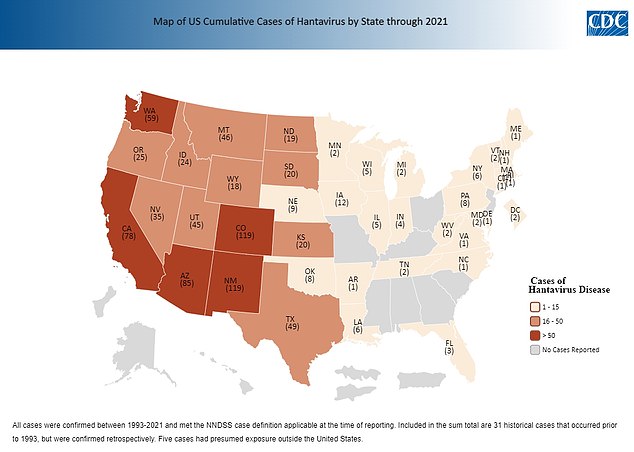Man in Arkansas catches virus carried by RATS that has a 40% kill rate – after state scientists discovered ‘dangerous’ new strain
- The hantavirus is a deadly group of viruses that usually spread between animals
- It is transmitted to humans through contact with rodent feces or through polluted air
- READ MORE: My beloved Yorkshire Terrier died of a mysterious new canine disease
A man in Arkansas has been infected with a deadly virus transmitted by rats — months after scientists discovered a brand new strain in the state.
The Little Rock patient was diagnosed with hantavirus, a family of viruses that kill about 38 percent of patients and spread through rodent feces.
This is the first time the disease has been confirmed in a person in Arkansas. Tests are being conducted to find the exact strain he is infected with.
It comes after researchers at the University of Arkansas discovered a never-before-seen variant that they said could be one of “the most dangerous” yet.
The team named it the Ozark virus after it was found in cotton rats in the Ozarks during the pandemic.
The virus can be transmitted to humans through contact with rodent feces and breathing air contaminated with steam from rodent feces

About 300 Americans contract hantaviruses each year, and the fatality rate can be as high as 60 percent
No details have been revealed about the Little Rock patient, but DailyMail.com has reached out to the state health department for more information.
Approximately 800 Americans become ill from the disease every year and it is estimated that 300 fatalities are also recorded.
Lead researcher Nathaniel Mull, who discovered the Ozark virus in 2021, told local media about the discovery last week as news emerged of the latest infection.
“I set out to catch rodents with the aim of finding out which hantaviruses they were infected with,” he told THV11. 'So I didn't expect to find a new one in it.
“These may be the most dangerous because we don't know what they are carrying or where they are at any given time.”
Kristian Forbes, who has researched the disease at the University of Arkansas, told THV11: “It is similar to a severe flu that can develop into symptoms or complications involving the heart and lungs.”
When a human is infected with a hantavirus, he can develop a disease called Hantavirus Pulmonary Syndrome.
About one to eight weeks after infection, patients usually suffer from fever, muscle aches, headache, nausea, vomiting and fatigue.
Four to 10 days later, the illness progresses to shortness of breath and a feeling like a “tight band around the chest and a pillow over the face,” as one survivor described it.
The disease attacks the blood vessels in the lungs, causing them to leak and fill the lungs with fluid. This can lead to suffocation and death.
Doctors treat the disease using ventilators to ensure patients get enough oxygen and IV drips to ensure they get enough nutrients and stay hydrated.
Medications may also be administered to help manage the pain, fever, and other symptoms.
Mr Forbes said: 'There is no known human-to-human transmission of hantaviruses so it will not spread to an epidemic or pandemic, but there is still the risk of human disease, isolated cases, possibly clusters of diseases in humans.'
In Chile and Argentina, rare cases of person-to-person transmission have occurred among close contacts of someone sick with a hantavirus called Andean virus.
There is no specific treatment, cure, or vaccine for hantavirus infection.
